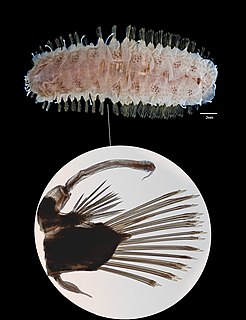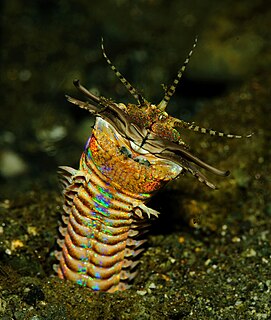
In invertebrates, the term parapodium refers to lateral outgrowths or protrusions from the body. Parapodia are predominantly found in annelids, where they are paired, unjointed lateral outgrowths that bear the chaetae. In several groups of sea snails and sea slugs, 'parapodium' refers to lateral fleshy protrusions.

Eunicida is an order of polychaete worms.

Phyllodoce is a genus of polychaete worms, which contains about 200 species. The prostomium bears eyes, two pairs of antennae and a pair of large retractile nuchal organs. The eversible proboscis is clearly divided into two parts.

Phyllodocida is an order of polychaete worms in the subclass Aciculata. These worms are mostly marine though some are found in brackish water. Most are active benthic creatures, moving over the surface or burrowing in sediments, or living in cracks and crevices in bedrock. A few construct tubes in which they live and some are pelagic, swimming through the water column. There are estimated to be about 3,500 species in the order.

Errantia, occasionally Aciculata, is a subclass of polychaete worms. These worms are found worldwide in marine environments and brackish water.
The Onuphidae are a family of polychaete worms.

Eulalia viridis is a species of bright-green polychaete worm in the family Phyllodocidae. It can range from 5 to 15 cm in length and is usually found in shallow north Atlantic water under rocks or in mussel beds.

Phyllodoce mucosa is a species of polychaete worm in the family Phyllodocidae. It is found intertidally in both the Pacific and Atlantic Oceans, typically on sandy or muddy seabeds.

Phyllodoce maculata is a species of Polychaete worm in the family Phyllodocidae. It is native to the northeastern Atlantic Ocean where it inhabits shallow water areas of sand, mud and stones.
Eulalia clavigera is a species of polychaete worm in the family Phyllodocidae, native to the coasts around Britain, through Western France, and to the Iberian Peninsula. It closely resembles Eulalia viridis, and there has been confusion in the past as to the identification of the two species.

Leucia is a genus of marine polychaete worms belonging to the family Polynoidae, the scaleworms. Leucia contains 2 species, both found in the northern Atlantic Ocean. This genus is distinguished from the closely related genus Harmothoe by having sixteen pairs of elytra, as opposed to fifteen.

Leucia nivea is a species of polychaete worm, commonly known as a "scale worm", in the family Polynoidae. This species occurs in the northeastern Atlantic Ocean, the North Sea and the Mediterranean Sea.

Eunoe is a genus of marine annelids in the family Polynoidae. The genus includes 48 species which are found world-wide, mostly from depths of 50 m or more.

Phyllodoce lineata is a species of polychaete worm in the family Phyllodocidae. It is native to the northeastern Atlantic Ocean and the Mediterranean Sea where it occurs in the intertidal and shallow sub-tidal zones on soft sediment.
Antipathipolyeunoa is a genus of marine annelids in the family Polynoidae. The genus contains a single species, Antipathipolyeunoa nuttingi, found in the Caribbean Sea at a depth of 91 metres.
Austropolaria is a genus of marine annelids in the family Polynoidae. The genus includes a single species, Austropolaria magnicirrata, which is known only from the Amundsen Sea in the Southern Ocean, at depths of 1000 to 1500m.
Bylgides is a genus of marine annelids in the family Polynoidae. The genus contains 9 species, all found in the Northern Hemisphere and from shallow inshore waters to depths of about 5000 m.
Eucranta is a genus of marine annelids in the family Polynoidae. The genus includes 5 species which are globally distributed from depths of about 40 to 600 m, mostly from high latitudes in the northern and southern hemispheres.
Gattyana amondseni is a scale worm described from the Arctic and North Atlantic Oceans at depths down to about 700 m.
Gattyana pohaiensis is a scale worm described from the Yellow Sea at depth down to 26 m.










